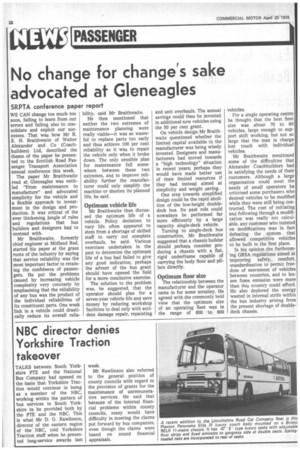No change for change's sake advocated at Gleneagles
Page 24

If you've noticed an error in this article please click here to report it so we can fix it.
SRPTA conference paper report
WE CAN change too much too soon, failing to learn from our errors and failing also to consolidate and exploit our successes. That was how Mr R. E. H. Braithwaite of Walter Alexander and Co (Coachbuilders) Ltd, described the theme of the paper he presented to the Scottish Road Passenger Transport Association annual conference this week.
The paper Mr Braithwaite read at Gleneagles was entitled "From maintenance to manufacture" and advocated simplicity for the vehicle and a flexible approach to investment in the design and production. It was critical of the ever thickening jungle of rules and regulations that bus builders and designers had to contend with.
Mr Braithwaite, formerly chief engineer at Midland Red, started his paper at the grass roots of the industry by saying that service reliability was the most important factor in retaining the confidence of passengers. He put the problems caused by increasing vehicle complexity very concisely by emphasising that the reliability of any bus was the product of the individual reliabilities of its constituent parts. One weak link in a vehicle could drastically reduce its overall relia bility, said Mr Braithwaite.
He then mentioned that neither the two extremes of maintenance planning were really viable—it was as wasteful to replace parts too early and thus achieve 100 per cent reliability as it was to repair the vehicle only when it broke down. The only sensible plan for maintenance fell somewhere between these two extremes, and to improve reliability further the manufacturer could only simplify the machine or shorten its planned life, he said.
Optimum vehicle life
Mr Braithwaite then discussed the optimum life of a vehicle. Policy decisions to vary life often appeared to stem from a shortage of skilled staff to carry out complete overhauls, he said. Various exercises undertaken in the past to determine the optimum life of a bus had failed to give any good indication; perhaps the advent of the bus grant should have opened the field for a more conclusive exercise.
The solution to the problem was, he suggested, that the operator should plan for a seven-year vehicle life and save money by reducing workshop facilities to deal only with accident damage repair, repainting and unit overhauls. The annual savings could then be invested in additional new vehicles using the 50 per cent grant.
On vehicle design Mr Braithwaite questioned whether the limited capital available to the manufacturer was being wisely invested. Designers and manufacturers had moved towards a "high technology" situation in recent years; perhaps they would have made better use of their limited resources if they had instead aimed at simplicity and weight saving.
One step towards simplified design could be the rapid abolition of the low-height doubledeck bus. Its past role could nowadays be performed far more efficiently by a large capacity single-deck vehicle.
Turning to single-deck bus construction, Mr Braithwaite suggested that a chassis builder should perhaps consider producing a chassis with a flat, rigid underframe capable of carrying the body floor and pillars directly.
Optimum floor size
The relationship between the manufacturer and the operator came in for some scrutiny. He agreed with the commonly held view that the optimum size of an operating fleet was in the range of 600 to 800 vehicles.
For a single operating centre he thought that the best fleet size was about 70 to 80 vehicles, large enough to support shift working, but not so large that the man in charge lost touch with individual vehicles.
Mr Braithwaite mentioned some of the difficulties that Alexander Coachhuilders had in satisfying the needs of their customers. Although a large organisation could meet the needs of small operators he criticised some purchasers who desired vehicles to be modified while they were still being contructed. The cost of initiating and following through a modification was really not calculable, any customer who insisted on modifications was in fact defeating the system that allowed competitive vehicles to be built in the first place.
In his opinion the forthcoming GRSA regulations aimed at improving safety, comfort, standardisation to permit freedom of movement of vehicles between countries, and to lessen fume emission were more than this country could afford. He also deplored the energy wasted in internal strife within the bus industry arising from the present shortage of doubledeck chassis.




















































































